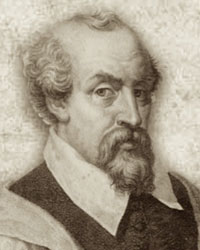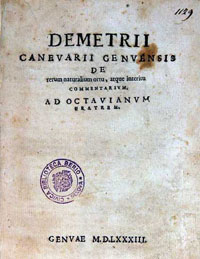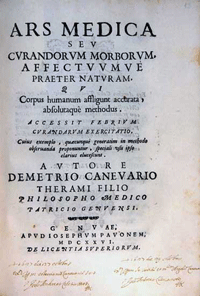



Demetrio Canevari
Genova 1559 - Roma 1625
Member of a mercantile family, he was born in Genoa in 1559. His father wanted him to become a doctor, and he studied medicine first in Padua and then in Rome. He obtained his degree in 1581 in Genoa. He then went back to Rome where he quickly became personal doctor to the relatives of the Pope. He also served in the Compagnia del S.S. Sacramento. He was papal archiatra during the brief reign of Urban VII, from September 14th to September 27th 1590. He lived in Rome forty years, and died there in 1625.
He wrote several works of natural philosophy and medicine, among them there the Instituta medicinalia, the De rerum naturalium ortu atque interitu commentarium (1583), the De ligno sancto commentarium (1602) and the works published posthumously by his heirs, according to his will, the Ars medica and the De primis rerum natura factarum principiis. His writings are focused on the Aristotelian principles of ‘matter’ and ‘form’, and in particular on the efficient agent. The author of these works was not at ease with the new astronomical theories, which he did not share, and was indifferent to the anatomical discoveries which undermined Aristotelian-galenic physiology. His approach to illness was generalized.
Even the De ligno sancto has an Aristotelian backbone. In this work Canevari offers his opinion of guaiaco or holy wood, employed to heal syphilis. Like Fracanziano, Fernel, Massa, Mattioli, and against Brasavola, Lobellius, Falloppio and Gallo, he believed that only guaiaco from Santo Domingo could be considered genuine.
Bibliography: Catalogo del Fondo Canevari della Biblioteca Berio di Genova, a cura di R. Savelli, Firenze, La Nuova Italia 1974; A. De Ferrari, Canevari (Canevaro), Demetrio, in Dizionario Biografico degli Italiani, vol. 18 (1975); Dizionario Biografico dei Liguri, vol. II, Genova, Consulta ligure 1994, ad vocem a cura di A. Lercari; R. Savelli, La "libraria" di Demetrio Canevari, in Da tesori privati a bene pubblico. Le collezioni antiche della Biblioteca Berio di Genova, Pisa, Pacini 1998, pp. 91-106; L. Malfatto, E. Ferro (a cura di), Biblioteca civica Berio, Saperi e meraviglie: tradizione e nuove scienze nella libraria del medico genovese Demetrio Canevari, Genova, Sagep libri & comunicazione 2004; V. Tigrino, L’Archivio Storico dell’Opera Pia “Sussidio Canevari Demetrio”: introduzione storica e inventario, in «La Berio», XLVIII (2008), n. 1, pp. 62-96.